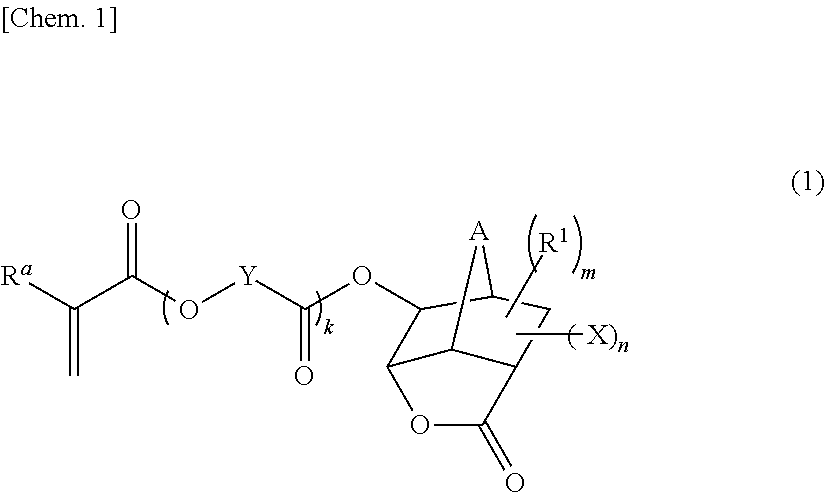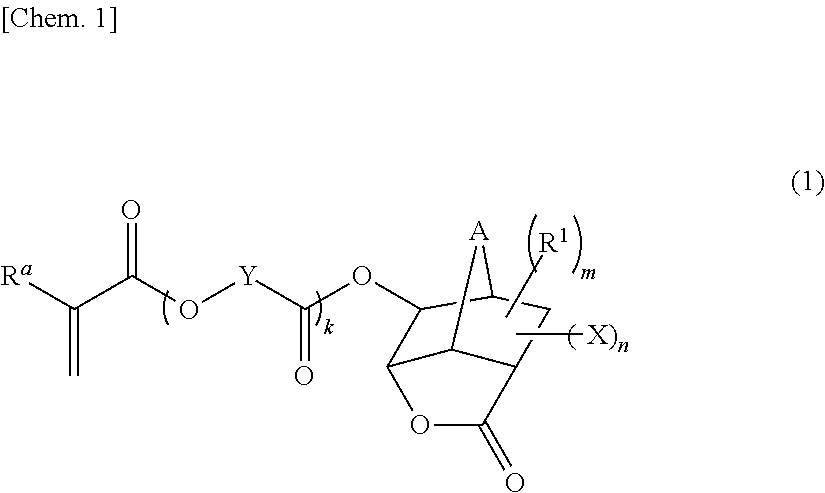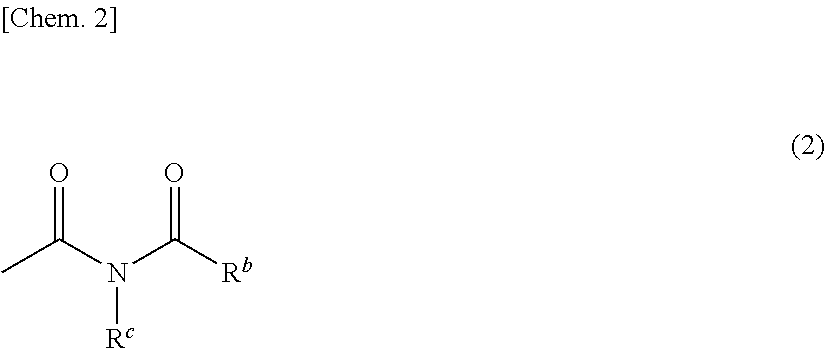Monomer having n-acyl carbamoyl group and lactone skeleton, and polymeric compound
a monomer and carbamoyl group technology, applied in the field of monomers and polymeric compounds for photoresists, can solve the problems of low capacity of monomers using these protecting groups, poor adhesion of resins to substrates, and lack of affinity typical for alkaline developers, etc., to achieve excellent solubility, easy penetration into polymers, and maintain stability
- Summary
- Abstract
- Description
- Claims
- Application Information
AI Technical Summary
Benefits of technology
Problems solved by technology
Method used
Image
Examples
example 1
[0106]There was prepared 1-(N-acetylcarbamoyl)-5-methacryloyloxy-3-oxatricyclo[4.2.1.04,8]nonan-2-one according to the reaction formula:
[0107]In a nitrogen-purged, 100-ml three-neck flask equipped with a stirrer, were placed 5 g (20.2 mmol) of 1-cyano-5-methacryloyloxy-3-oxatricyclo[4.2.1.04,8]nonan-2-one and 10.5 g of concentrated hydrochloric acid, followed by mixing with stirring. The stirring was performed for 46 hours while maintaining the liquid temperature at 15° C. to 25° C. on a water bath. The resulting mixture was cooled on an ice bath and combined with 90 g of water added dropwise over 30 minutes while maintaining the internal temperature at 0° C. to 5° C. Precipitated crystals were filtrated, rinsed with 5 g of water two times, and yielded crude crystals. The crude crystals were subjected to silica gel column chromatography and yielded 1.7 g (6.4 mmol) of 1-carbamoyl-5-methacryloyloxy-3-oxatricyclo[4.2.1.04,8]nonan-2-one in a yield of 32%. The NMR spectral data of this ...
example 2
[0111]There was prepared 1-(N-acetylcarbamoyl)-5-(2-methacryloyloxyacetoxy)-3-oxatricyclo[4.2.1.04,8]nonan-2-one according to the reaction formula:
[0112]In a nitrogen-purged, 200-ml three-neck flask equipped with a stirrer, were placed 3.0 g (9.8 mmol) of 1-cyano-5-(2-methacryloyloxyacetoxy)-3-oxatricyclo[4.2.1.04,8]nonan-2-one and 10.0 g (98 mmol) of acetic anhydride, followed by mixing with stirring. The mixture was combined with 3.3 g of (12.8 mmol) of tin(IV) chloride while maintaining the liquid temperature at 25° C. or lower on a water bath, followed by stirring at a liquid temperature of 80° C. for 6 hours. After the completion of the reaction, the reaction mixture was cooled on an ice bath, combined with 100 g of ethyl acetate and 130 g of 5 N hydrochloric acid, and stirred for 30 minutes while maintaining the internal temperature at 25° C. or lower. An organic phase was separated, further combined with 200 g of ethyl acetate and 300 g of 5 N hydrochloric acid, and stirred f...
example 3
Synthesis of Polymeric Compound (Copolymer) Having Structure
[0114]
[0115]In a nitrogen atmosphere, 59.5 g of cyclohexanone were placed in a round-bottomed flask equipped with a reflux condenser, a stirring bar, and a three-way stopcock and, while maintaining the temperature at 80° C. with stirring, combined with a monomer solution added dropwise at a constant rate over 6 hours. The monomer solution was a mixture of 13.41 g (43.7 mmol) of 1-(N-acetylcarbamoyl)-5-methacryloyloxy-3-oxatricyclo[4.2.1.04,8]nonan-2-one, 5.15 g (21.8 mmol) of 1-hydroxy-3-methacryloyloxyadamantane, 11.44 g (43.7 mmol) of 1-(1-methacryloyloxy-1-methylethyl)adamantane, 1.80 g of dimethyl 2,2′-azobisisobutyrate [trade name V-601, Wako Pure Chemical Industries, Ltd.], and 110.5 g of cyclohexanone. After the completion of the dropwise addition, the resulting mixture was continuously stirred for further 2 hours. After the completion of the polymerization reaction, the reaction mixture was added dropwise to a stirr...
PUM
| Property | Measurement | Unit |
|---|---|---|
| wavelength | aaaaa | aaaaa |
| solubility | aaaaa | aaaaa |
| line widths | aaaaa | aaaaa |
Abstract
Description
Claims
Application Information
 Login to View More
Login to View More - R&D
- Intellectual Property
- Life Sciences
- Materials
- Tech Scout
- Unparalleled Data Quality
- Higher Quality Content
- 60% Fewer Hallucinations
Browse by: Latest US Patents, China's latest patents, Technical Efficacy Thesaurus, Application Domain, Technology Topic, Popular Technical Reports.
© 2025 PatSnap. All rights reserved.Legal|Privacy policy|Modern Slavery Act Transparency Statement|Sitemap|About US| Contact US: help@patsnap.com



